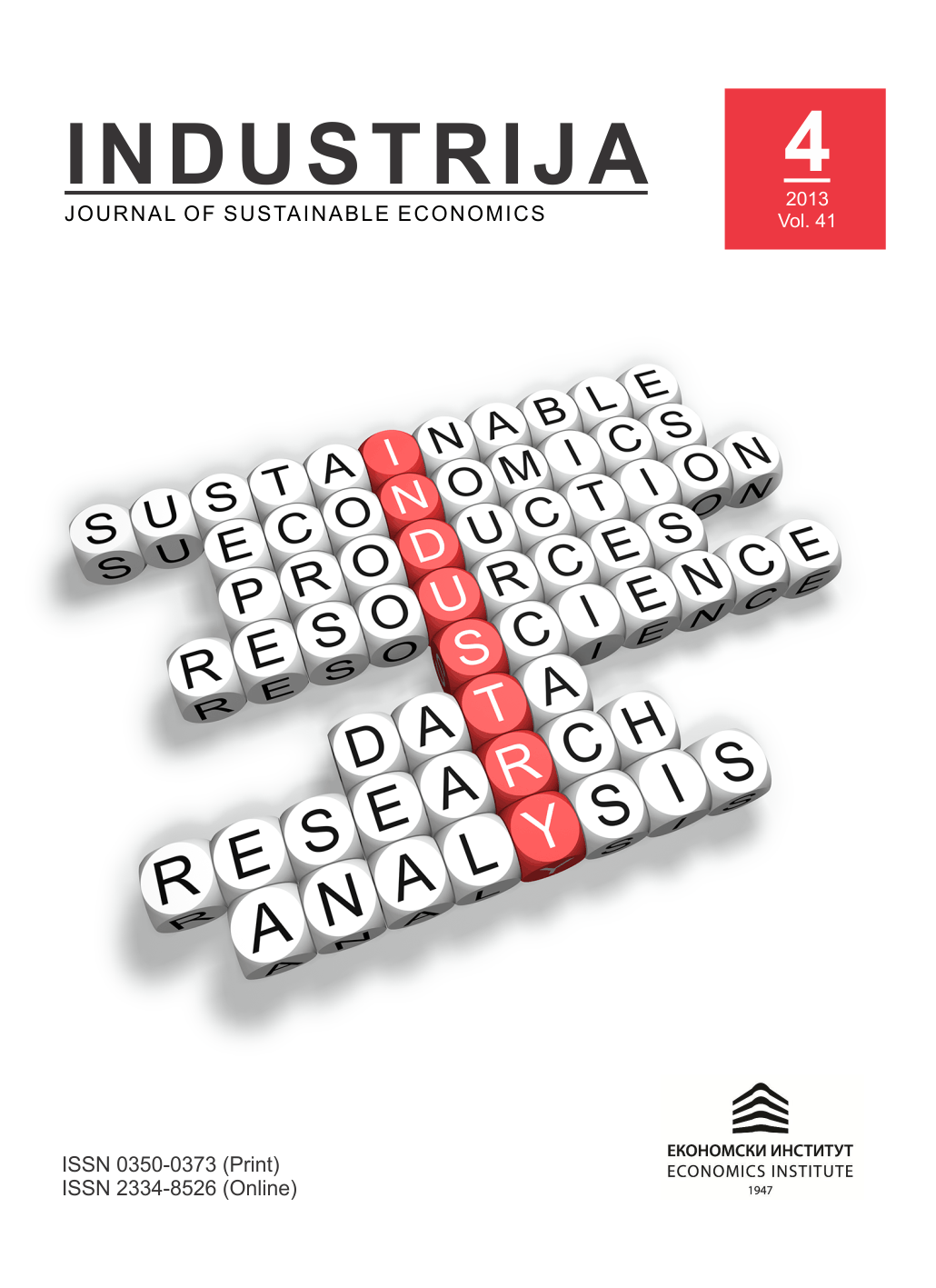Non-performing loans and systemic risk: comparative analysis of Serbia and countries in transition CESEE
Abstract
This paper presents the results of the research on the impact of non-performing loans to the systemic risk in the domestic banking system and a comparison with other countries in transition, as well as on certain EU countries. It is important to metion that the extreme bank-centricity caused the extension of the analysis to the entire financial sector of Serbia. Therefore, macroeconomic and macro-financial component of systemic risk were separated. In order to more precisely determine the main effects of non-performing loans in the propagation of systemic risk, the authors have created and used two new synthetic indicators in the research. The first is the macroeconomic contagion with non-performing loans (problematic loans expressed as a percentage of GDP), and the second is the infection of financial sector with non-performing loans (the proportional share of these loans in the assets of the financial sector). Analysis of the period just before and during the current financial crisis and the recession (2007-2012) showed that the NPLs (non-performing loans) are the main generator of systemic risk in the financial and real sectors of Serbia. In addition, the survey results show that the applied synthetic indicators measure total system risk and its basic components more accurately then the analytical, which have only been in use until now. Comparative analysis showed similar results, not only in the countries in transition, but also in developed ones. The results of this study provide guidance and represent an important input for economic policymakers, because the systemic risk is the greatest immediate threat to economic prosperity and financial stability of each country
References
Bank of England (2013). Systemic Risk Survey – Survey Results 2013 H1. Bank of England.
Beck, R., Jakubik, P. & Piloiu, A. (2013). Non-performing loans: what matters in addition to the economic cycle? Working papers 1515/2013.Frankfurt: European Central Bank.
BIS (2009). Guidance to Assess the Szstemic Importance of Financial Institutions, Markets and Instruments: Initial Considerations. Basel: Bank for International Settlements.
Bordo, M. & Haubrich, J. (2010). Credit crises, money and contractions: An historical view. Journal of Monetary Economics, 57, 1-18.
Browne, F., Llewellyn, D. & Molyneux, P. (Eds.). (2011). Regulation and Banking after Crisis. SUERF Study 2011/2. Vienna: SUERF.
Brownless, C. & Engle, R. (2011). Volatility, Correlation and Tails for Systemic Risk Measurement. Working Paper. New York Univerity.
Buncic, D. & Melecky, (2012). Macroprudential Stress Testing of Credit Risk: A practical Approach for Policy Makers. Policy research working paper, WPS 5936. The World Bank.
Cao, J. & Illing, G. (2011). Endogenous Exposure to Systemic Liquidity Risk. International Journal of Central Banking, June 2011, 7(2), 173-216.
Caruana, J. (2010). Systemic risk: how to deal with it? Other publications. Basel: Bank for International Settlements.
Dijkman, M. (2010). A Framework for Assessing Systemic Risk. Policy research working paper, WPS 5282. The World Bank.
EBC „Vienna“ Initiative (2012). Working Group on NPLs in Central, Eastern and Southeastern Europe. European Banking Coordination „Vienna“ Initiative.
ESRB (2011). Annual Report 2011. European Systemic Risk Board.
European Parliament (2009). Defining and Measuring Systemic Risk. Note, 23 November.
Furceri, D. & Zdzienicka, A. (2011). The real effect of economic crises in the European transition economies. Economics of Transition, 19(1), 1-25.
Group of Ten (2001). Report on Consolidation in the Financial Sector. BIS, IMF & OECD.
IMF (2010). Systemic Risk and the Redesign of Financial Regulation. In Global Financial Stability Report, April 2010, Chapter 2 (pp. 1-27). International Monetary Fund.
Klein, (2013). Non-Performing Loans in CESEE: Determinants and Impact on Macroeconomic Performance. IMF Working Paper, 72. International Monetary Fund.
Laeven, L. & Valencia, F. (2012). Systemic banking crises Database: An Update. IMF Working Paper, 12/163. International Monetary Fund.
Mishkin, F. (2007). Money, Banking and Financial Markets. Eighth edition. Boston: Pearson Addison Wesley.
NBS (2013b). Izveštaj o inflaciji - Maj 2013. Narodna banka Srbije.
NBS (2012). Godišnji izveštaj o stanju finansijskog sistema 2011. Narodna banka Srbije.
NBS (2013). Godišnji izveštaj o stanju finansijskog sistema 2012. Narodna banka Srbije.
NBS (2013a). Bankarski sektor u Srbiji – Izveštaj za IV tromesečje 2012. April 2013. Narodna banka Srbije.
NBS (2013c). Tromesečni pregled kretanja indikatora finansijske stabilnosti Republike Srbije – Za I tromesečje 2013. godine. Maj 2013. Narodna banka Srbije.
Nkusu, M. (2011). Nonperforming Loans and Macrofinancial Vulnerabilities in Advanced Economies. IMF Working Paper, 11/161. International Monetary Fund.
Scheiber, T. & Stix, H. (2009). Euroization in Central, Eastern and Southeastern Europe - New Evidence On Its Extent and Some Evidence On Its Causes. OeNB Working papers, 159. Oesterreichische Nationalbank.
Schreiner, J. (Ed.). (2013). Development in Selected CESEE Countries: Economic Downturn Continues in an Adverse International Environment. Focus on European Economic Integration, Q2/13, 8-19. Oesterreichische Nationalbank.
Vuković, V. (2011). Banking sector: comparative analysis Serbia vs EU Member states. In J. Andrade, P. Teixeira & M. Radović-Marković (Eds.), Serbia and the European Union: economic lessons from the new Member states, Chapter 18 (pp. 282-296). Coimbra (Portugal) : University of Coimbra – Faculty of Economics.
World Bank. (2013). World Bank/Data/Financial Sector. Retrived from http://data.worldbank.org/

